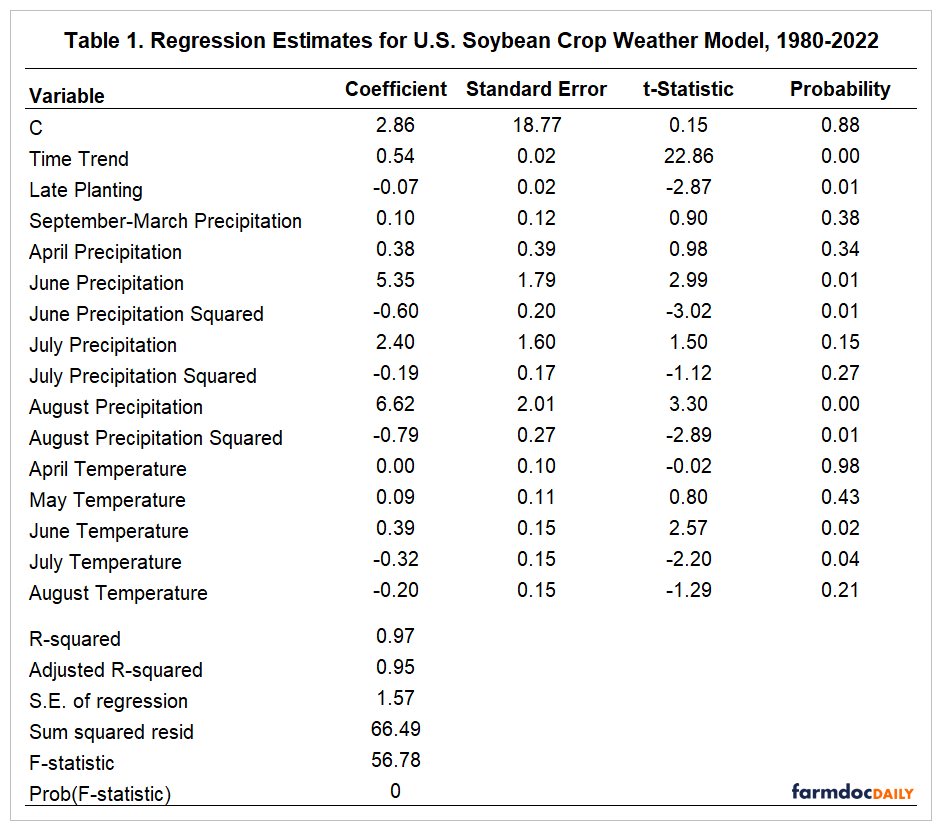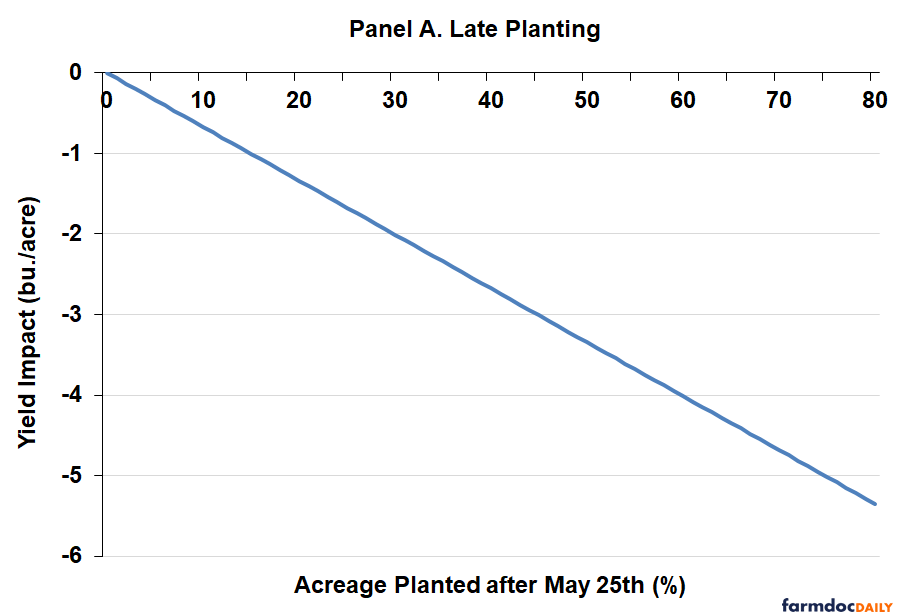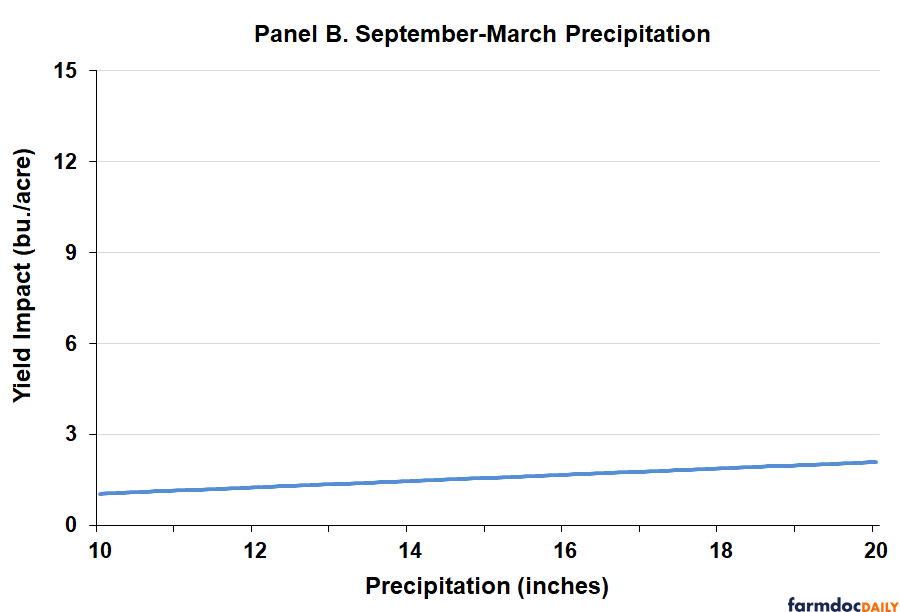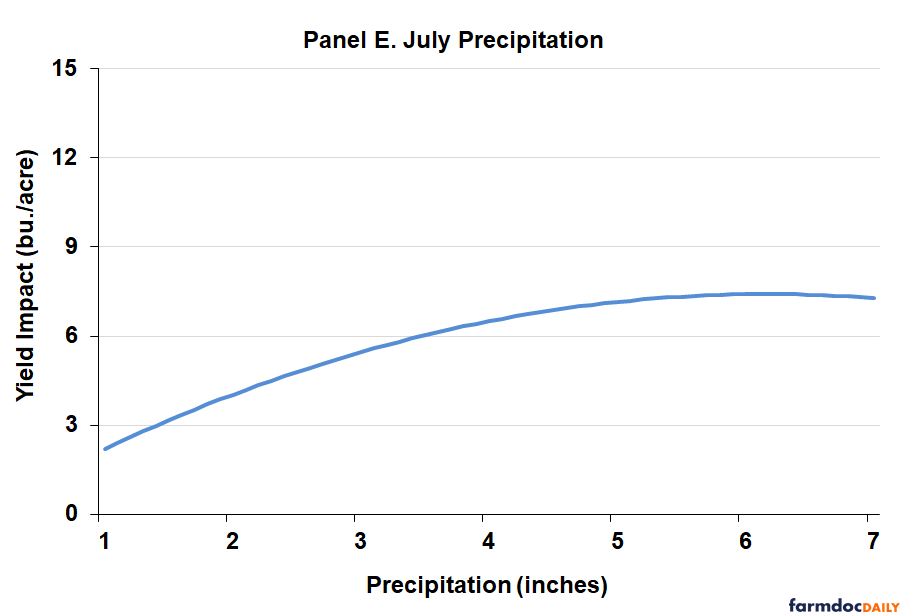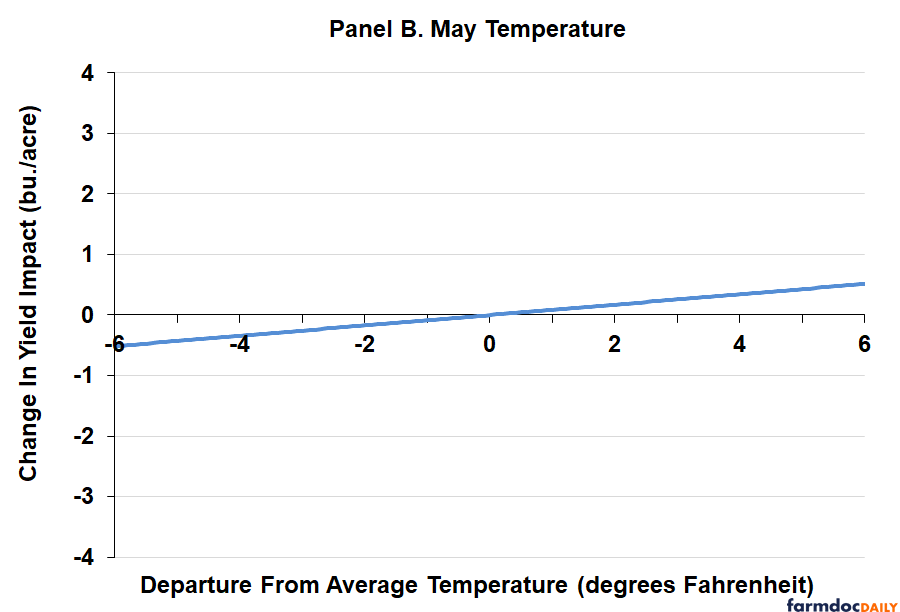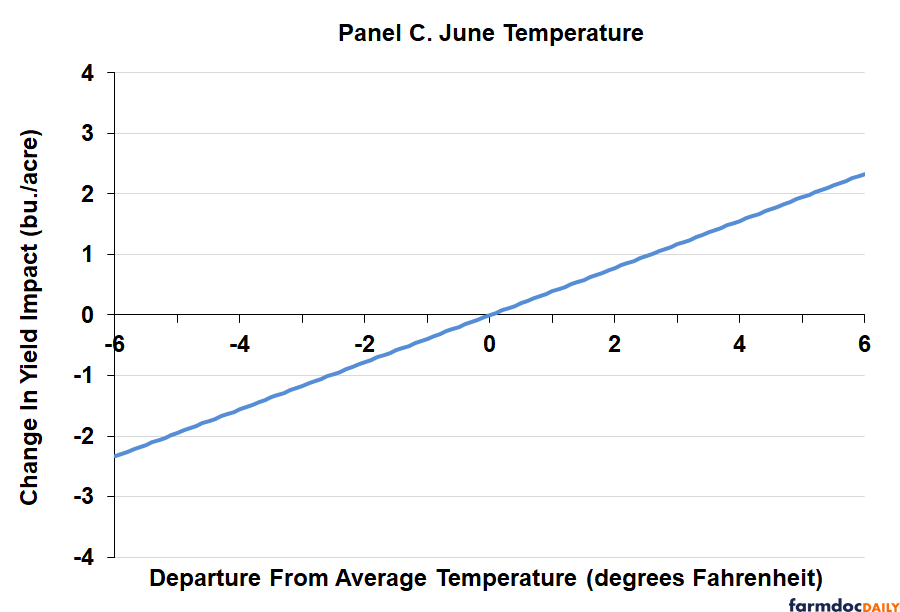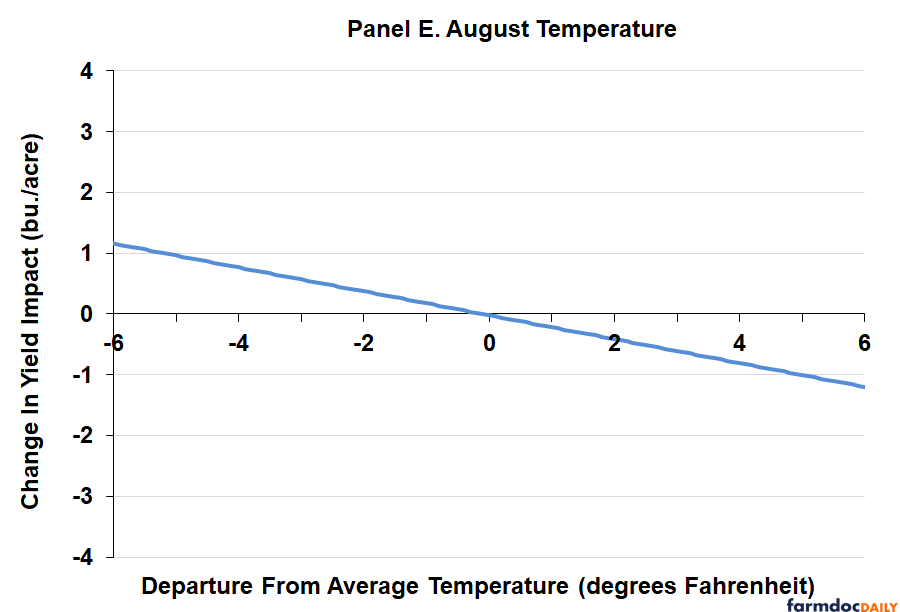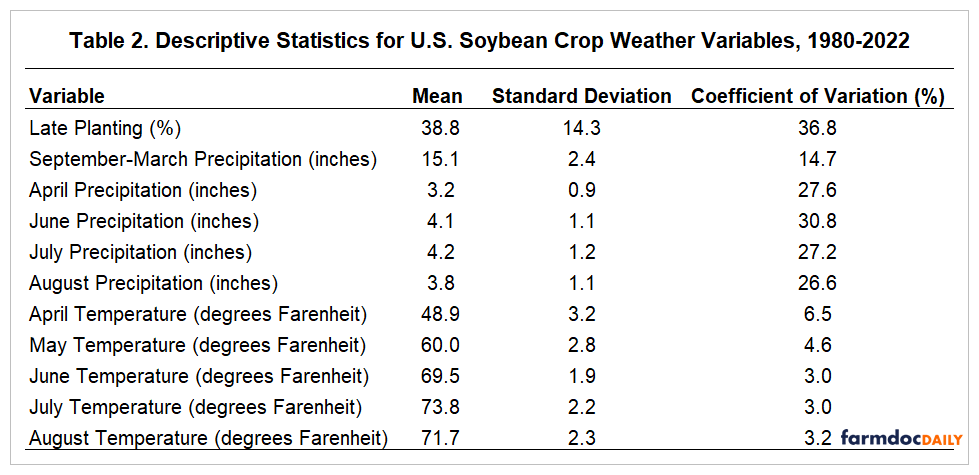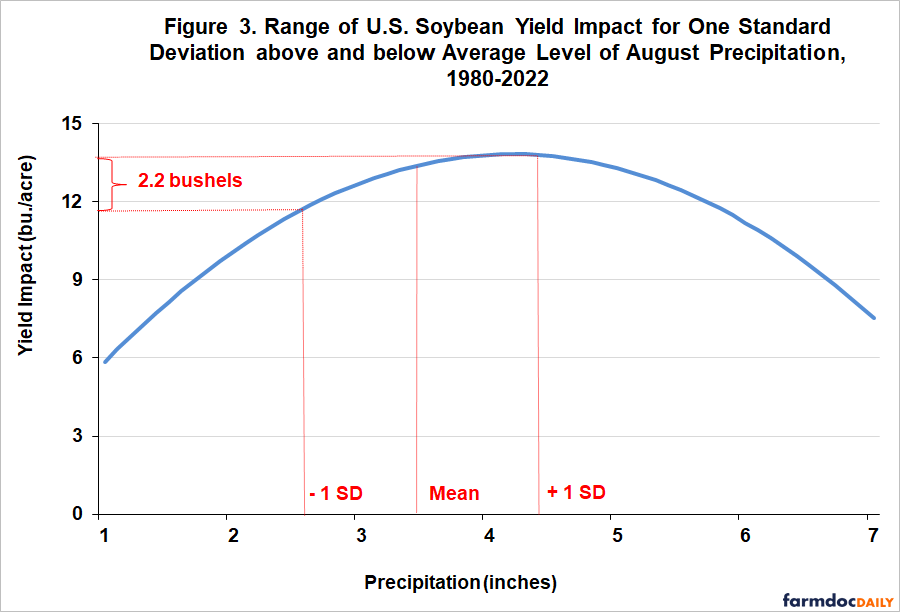The Relative Impact of Crop Weather Variables on the U.S. Average Yield of Soybeans
A perennial question in the grain markets is the impact of weather during different parts of the growing season on final yield. While every growing season is unique in some respects, it is well-known that weather during certain periods is generally a more important determinant of final yield than others, with the crucial reproductive periods for corn and soybeans a prominent example. What is not as well-known is the relative magnitude of such impacts. In other words, how much more important is the impact of weather in, say, June versus August? Answering this question requires a statistical model to disentangle the impacts of the different weather variables that influence yield. In a recent farmdoc daily article (October 9, 2023), a crop weather model was used to estimate the relative impacts of important weather variables on the U.S. average yield of corn, and it was found that July precipitation is easily the most important variable. The purpose of today’s article is to use a similar regression crop weather model to estimate the relative impacts of important weather variables on the U.S. average yield of soybeans.
Analysis
We begin by estimating a “Thompson-style” crop weather regression model that relates the U.S. average soybean yield to a time trend, the percentage of the crop planted late, and an array of weather variables. The model is a slightly modified version of one used in several earlier farmdoc daily articles (May 20, 2020; June 25, 2020; July 23, 2020). While many other specifications can, and have been, used in the literature (see Tannura, Irwin, and Good, 2008), this model has been shown to be reasonably accurate and it captures the main crop weather factors that influence the U.S. average yield of soybeans. The version of the model estimated here uses data for 1980 through 2022 and includes the following explanatory variables: i) a linear time trend variable to represent technological change, ii) the percentage of the soybean crop planted late, iii) linear functions of preseason (September-March) and April precipitation, iv) quadratic functions of June, July, and August precipitation, and v) linear functions of April, May, June, July, and August temperatures. The late planting variable is defined as the percentage of U.S. soybeans acreage planted after June 5th from 1980-1985, May 30th from 1986-1999, and May 25th from 2000 forward. This is the same late planting variable analyzed in several previous farmdoc daily articles (e.g., May 25, 2022).
The monthly weather data are collected for 10 key soybean-producing states (Iowa, Illinois, Indiana, Minnesota, Missouri, Nebraska, North Dakota, Ohio, South Dakota, and Wisconsin). These 10 states typically accounted for about 70-75 percent of total U.S harvested acreage of soybeans during the sample period. Aggregate weather measures for the 10 states were constructed using harvested soybean acres to weight state-specific observations. The weighted-average monthly weather variables are used to represent weather observations for the entire U.S. soybean crop, similar to the procedure used by the World Agricultural Outlook Board of the USDA for estimating their soybean crop weather model (farmdoc daily, July 23, 2020). Precipitation data are monthly totals and temperature data are monthly averages. The National Weather Service is the source for the weather data via the Midwest Regional Climate Center.
Table 1 presents the regression estimates for the crop weather model. The model has a high explanatory power, with an R2 of 97 percent. The sign of the coefficient estimates generally are as expected. The time trend coefficient indicates that the trend rate of growth in the U.S. average soybeans yield over this time period was slightly more than a half a bushel per year. A quadratic time trend term was also considered but the quadratic term was not statistically significant. Each percentage of the U.S. soybeans crop planted late is estimated to reduce soybeans yield by 0.07 bushels per acre. Most of the crop weather variables are statistically significant at the ten percent level or better. It is surprising that neither of the July precipitation variables are significant. However, if a linear specification is considered for this variable, it is highly significant. We nevertheless include the quadratic term for July precipitation in the final model to be consistent with the other summer precipitation variables. Perhaps the most notable result is the positive and statistically significant coefficient for June temperature. This contrasts sharply with the negative estimated coefficients for July and August temperature.
Since it is difficult to interpret the coefficient estimates directly, particularly for the quadratic precipitation variables, Figures 1 and 2 plot the estimated relationships for each variable. The “hill-shaped” response of soybeans yield to June and July precipitation is highlighted in Figure 1, along with the large response of yield to August precipitation. Figure 2 plots the response of soybean yield to the temperature variables. The early season response to temperature in April and May is slightly positive, with a much larger positive response in June. The temperature response in July and August is negative, as noted above.
Figure 1. Estimated Response of U.S. Soybean Yield to Late Planting and Precipitation Variables, 1980-2022
Figure 2. Estimated Response of U.S. Soybean Yield to Temperature Variables, 1980-2022
While the plots in Figures 1 and 2 provide a useful perspective on the response of the U.S average soybean yield to crop weather variables, the plots do not tell the entire story. The reason is that the variation of the weather variables is not uniform. Table 2 demonstrates the point. Here, descriptive statistics for each variable are presented. The crucial information is provided by the coefficient of variation (COV), which is the standard deviation divided by the mean. This shows the dispersion of a variable as a percentage of its mean, or average. Standardizing in this manner reveals some interesting patterns. The most volatile variable is late planting, which has a COV of 36.8 percent. The COV for monthly precipitation variables ranges between about 27 and 31 percent by comparison. The variability of monthly temperatures is much smaller, roughly in the range of only three to six percent. The picture that emerges is that temperature varies relatively little compared to average levels, while precipitation and late planting are much more volatile.
The information presented in Table 2 indicates that analysis of the relative importance of crop weather variables on the yield of soybeans needs to consider both the nature of the relationship between the variables and yield and the inherent difference in the variation of the variables. Figure 3 uses August precipitation to demonstrate the procedure adopted here. This is the same relationship shown earlier in Panel E of Figure 1. In order to standardize for the differences in variability, a one-standard deviation range above and below the mean is considered. This should roughly include about two-thirds of the observations for each variable. In the case of August precipitation, a one-standard deviation below mean precipitation for the month is associated with an 11.6-bushel impact on yield, whereas a one-standard deviation above mean precipitation is associated with a 13.8-bushel impact on yield. The net result is that the U.S. average yield of soybeans varies by 2.2 bushels per acre for a one-standard deviation range in July precipitation. Alternatively, one can say that about two-thirds of the time the impact of July precipitation on the U.S. average yield of soybeans is within a range of 2.2 bushels.
The same computations as in Figure 3 were made for each of the crop weather variables included in the model. The results are ordered from largest to smallest and presented in Figure 4. While nearly all the crop weather variables impact soybean yield, August and July precipitation are easily the most important, with ranges of 2.2 and 2.1 bushels per acre, respectively. Late planting is a close third at 1.9 bushels. Some may be surprised by the importance of late planting. While the impact of each percentage point increase in late planting is small, the variability of late planting year-to-year is quite large, as shown earlier in Table 2. Hence, the wide range of late planting year-to-year accounts for its large impact. June and July temperature form the next most important group of variables, with ranges of 1.4 and 1.5 bushels, respectively. All of the remaining crop weather variables have ranges equal to or less than one bushel. In sum, the “big three” for determining the U.S. average yield of soybeans are August precipitation, July precipitation, and late planting, with August precipitation just edging out July precipitation for the top ranking.
It is interesting to compare the relative variation results for soybeans with those for corn, which were presented in a recent farmdoc daily article (October 9, 2023) In both corn and soybeans, precipitation during the crucial reproductive period has the largest influence on yield. For corn, it is precipitation during July, while it is both July and August precipitation for soybeans. This reflects that fact that the critical reproductive period for corn is more limited than for soybeans. The amount of the crop planted late is also very important for both corn and soybeans. While temperature is certainly relevant in determining the yield of both crops, it tends to play a secondary role compared to precipitation, especially for soybeans. Finally, the importance of the various crop weather variables is much more skewed for corn compared to soybeans. For example, the average impact of the top three crop weather variables in corn is four times the average impact of the other weather variables, whereas in soybeans the average impact of the top three variables is only about two-and-a-half times that of the other variables.
Implications
Whenever there is a wide range of weather conditions across time and space, as there has been this year, there is a great deal of interest in which weather variables were the most important in determining soybean yields. While there is a general understanding of the importance of different weather variables on soybean yield, there is less understanding about the relative magnitude of such impacts. In this article, a crop weather model is used to estimate the relative impacts of important weather variables on the U.S. average yield of soybeans. The crop weather regression model uses data for 1980 through 2022 to relate the U.S. average soybeans yield to a time trend, the percentage of the crop planted late, and an array of weather variables. We then consider a one-standard deviation range in impact for each of the crop weather variables to standardize for differences in the variation of each variable. The analysis shows that the “big three” for determining the U.S. average yield of soybeans are August precipitation, July precipitation, and late planting, with August precipitation just edging out July precipitation for the top ranking. About two-thirds of the time, the impact of either August or July precipitation on the U.S. average yield of soybeans is in a range of slightly more than two bushels per acre. Hence, both August and July precipitation are “golden numbers” for U.S. soybean yields.
References
Irwin, S. "The Relative Impact of Crop Weather Variables on the U.S. Average Yield of Corn." farmdoc daily (13):184, Department of Agricultural and Consumer Economics, University of Illinois at Urbana-Champaign, October 9, 2023.
Irwin, S. "What Do We Know About the Impact of Late Planting on U.S. Average Soybean Yield?" farmdoc daily (12):77, Department of Agricultural and Consumer Economics, University of Illinois at Urbana-Champaign, May 25, 2022.
Irwin, S. and T. Hubbs. "The Accuracy of Early Season Crop Weather Model Forecasts of the U.S. Average Soybean Yield." farmdoc daily (10):136, Department of Agricultural and Consumer Economics, University of Illinois at Urbana-Champaign, July 23, 2020.
Irwin, S. and T. Hubbs. "Understanding the WAOB Crop Weather Model for Soybeans." farmdoc daily (10):126, Department of Agricultural and Consumer Economics, University of Illinois at Urbana-Champaign, July 9, 2020.
Irwin, S. and T. Hubbs. "Unconditional vs. Conditional Trend Estimates for U.S. Corn and Soybeans." farmdoc daily (10):116, Department of Agricultural and Consumer Economics, University of Illinois at Urbana-Champaign, June 25, 2020.
Hubbs, T. and S. Irwin. "The Impact of Late Planting on U.S. Average Soybean Yield." farmdoc daily (10):93, Department of Agricultural and Consumer Economics, University of Illinois at Urbana-Champaign, May 20, 2020.
Tannura, M. A., S. H. Irwin, and D. L. Good. “Weather, Technology, and Corn and Soybean Yields in the U.S. Corn Belt.” Marketing and Outlook Research Report 2008-01, Department of Agricultural and Consumer Economics, University of Illinois at Urbana-Champaign, February 2008.
Disclaimer: We request all readers, electronic media and others follow our citation guidelines when re-posting articles from farmdoc daily. Guidelines are available here. The farmdoc daily website falls under University of Illinois copyright and intellectual property rights. For a detailed statement, please see the University of Illinois Copyright Information and Policies here.








